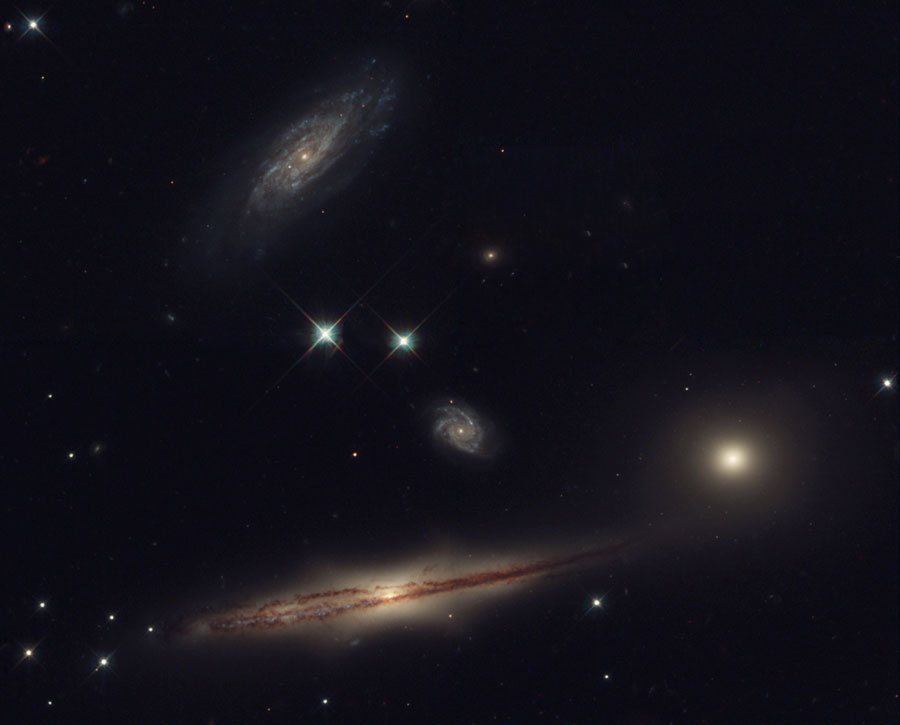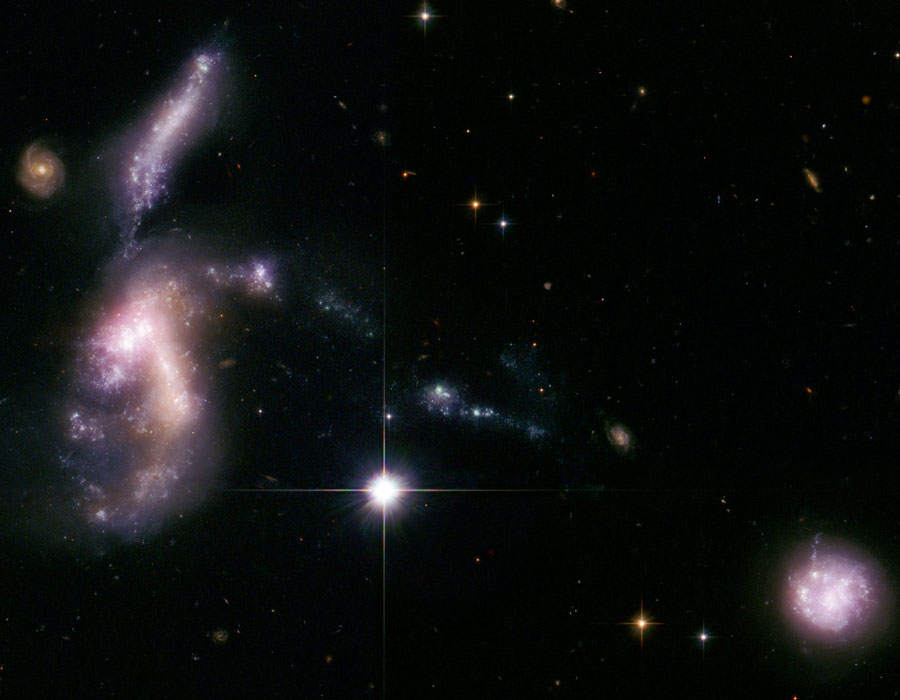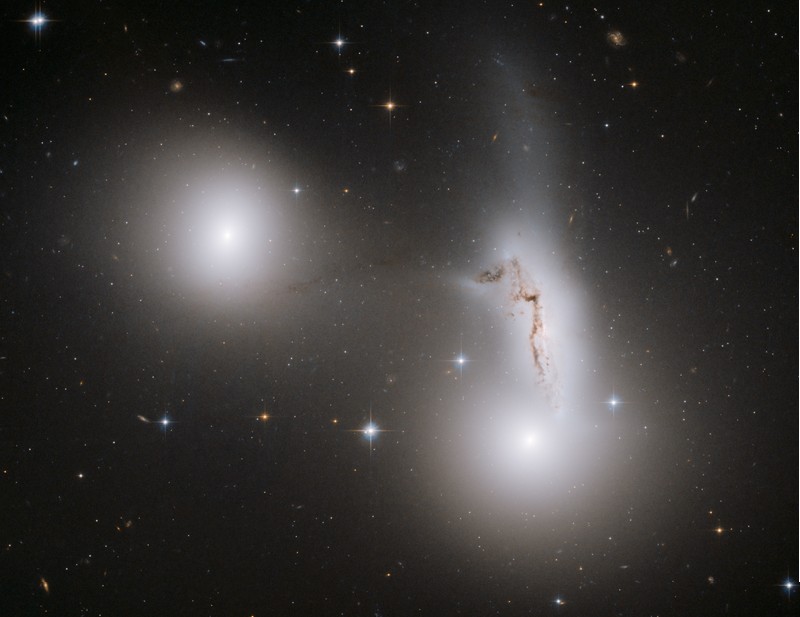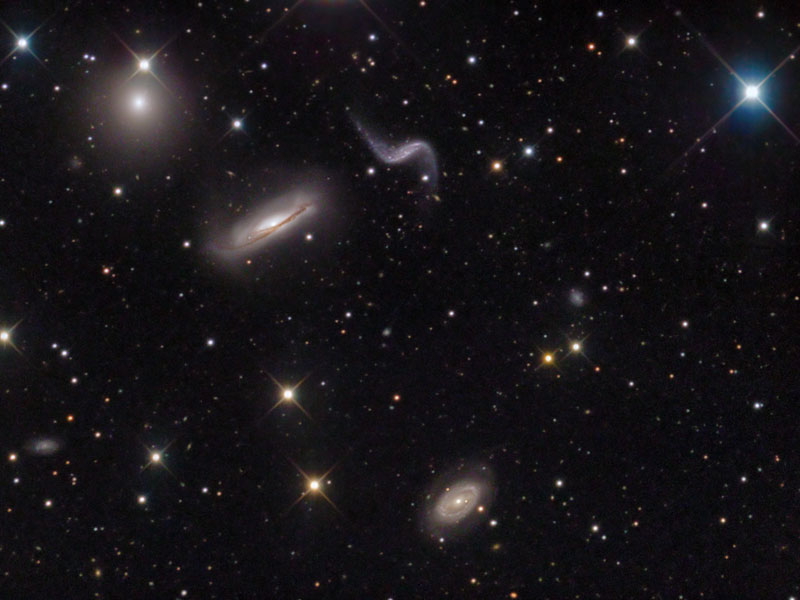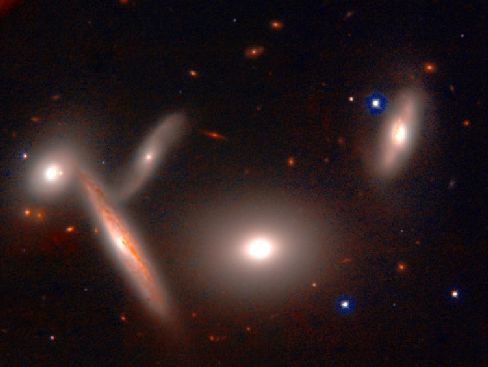Hickson Compact Groups (HCG)
All titles are clickable and link to the original APOD page. Click on an image for a larger view of it.
2010 July 6
1999 September 6
2010 February 22
2009 March 13 Scanning the skies for galaxies, Canadian astronomer Paul Hickson and colleagues identified some 100 compact groups of galaxies, now appropriately called Hickson Compact Groups (HCGs). This sharp Hubble image shows one such galaxy group, HCG 90, in startling detail. Three galaxies are revealed to be strongly interacting: a dusty spiral galaxy stretched and distorted between a pair of large elliptical galaxies. The close encounter will trigger furious star formation. On a cosmic timescale, the gravitational tug of war will eventually result in the merger of the trio into a large single galaxy. The merger process is now understood to be a normal part of the evolution of galaxies, including our own Milky Way. HCG 90 lies about 100 million light-years away in the constellation Piscis Austrinus. This Hubble view spans about 80,000 light-years at that estimated distance. Of course, Hickson Compact Groups also make for rewarding viewing for Earth-bound astronomers with more modest sized telescopes.
2007 March 19 Galaxies, like stars, frequently form groups. A group of galaxies is a system containing more than two galaxies but less than the tens or hundreds typically found in a cluster of galaxies. A most notable example is the Local Group of Galaxies, which houses over 30 galaxies including our Milky Way, Andromeda, and the Magellanic Clouds. Pictured above is nearby compact group Hickson 44. This group is located about 60 million light-years away toward the constellation of Leo. Also known as the NGC 3190 Group, Hickson 44 contains several bright spiral galaxies and one bright elliptical galaxy on the upper left. The bright source on the upper right is a foreground star. Many galaxies in Hickson 44 and other compact groups are either slowly merging or gravitationally pulling each other apart.
2005 July 16
2003 July 31 Posing for this cosmic family photo are the galaxies of HCG (Hickson Compact Group) 87, about four hundred million light-years distant toward the amphibious constellation Capricornus. The large edge-on spiral near picture center, the fuzzy elliptical galaxy immediately to its right, and the spiral near the top of the image are identified members of the group, while the small spiral galaxy in the middle is likely a more distant background galaxy. In any event, a careful examination of the deep image reveals other galaxies which certainly lie far beyond HCG 87. While not exactly locked in a group hug, the HCG 87 galaxies are interacting gravitationally, influencing their fellow group members' structure and evolution. This new image is from an instrument undergoing commissioning on the Gemini Observatory's South Telescope at Cerro Pachon, Chile. It compares favorably with views of this photogenic galaxy group recorded by the Hubble Space Telescope.
2001 March 9 Scanning the skies for galaxies Canadian astronomer Paul Hickson and colleagues identified some 100 compact groups of galaxies, now appropriately called Hickson Compact Groups (HCGs). With only a few member galaxies per group, HCGs are much smaller than the immense clusters of galaxies which lurk in the cosmos, but like the large galaxy clusters, some HCGs seem to be filled with hot, x-ray emitting gas. In fact, groups of galaxies like HCGs may be the building blocks of the large clusters. This false-color x-ray image from the orbiting Chandra Observatory reveals x-ray emission from the gas in one such group, HCG 62, in startling detail. In the image, black and green colors represent low intensities while red and purple hues indicate high x-ray intensities. Striking features of the x-ray image are the low brightness blobs at the upper left and lower right which symmetrically flank the intense central x-ray region. HCG 62 lies in Virgo, and near the group's center resides elliptical galaxy NGC 4761. At optical wavelengths, some HCGs make for rewarding viewing, even with modest sized telescopes.
1999 February 17 Galaxies, like stars, frequently form groups. A group of galaxies is a system containing more than two galaxies but less than the tens or hundreds typically found in a cluster of galaxies. A most notable example is the Local Group of Galaxies, which houses over 30 galaxies including our Milky Way, Andromeda, and the Magellanic Clouds. Pictured above is nearby compact group Hickson 40. This group is located about 300 million light-years away toward the constellation of Hydra. Of the five prominent galaxies in Hickson 40, three are spirals, one is an elliptical and one is a lenticular. Many galaxies in compact groups are either slowly merging or gravitationally pulling each other apart.
